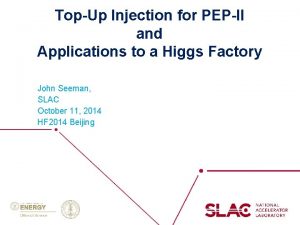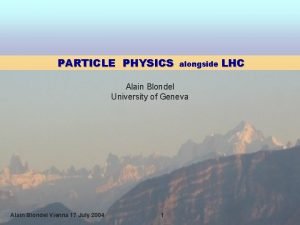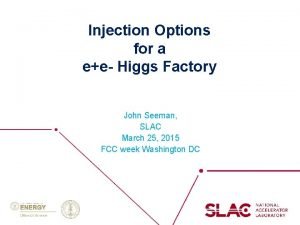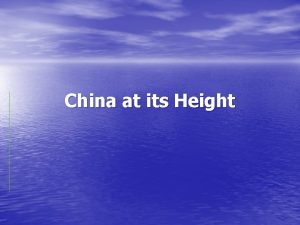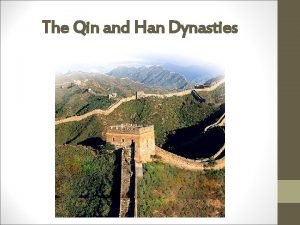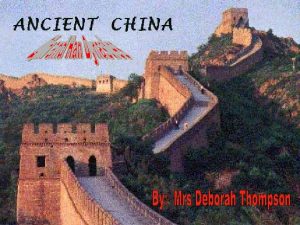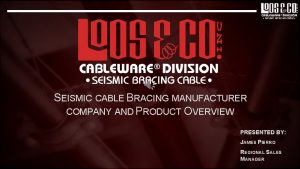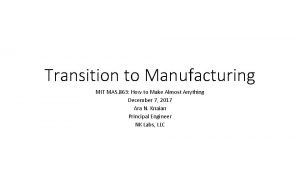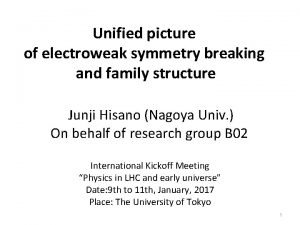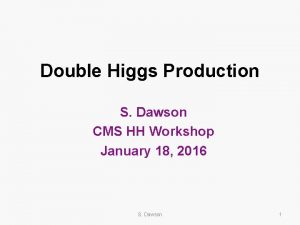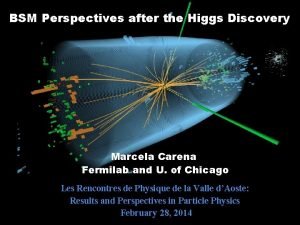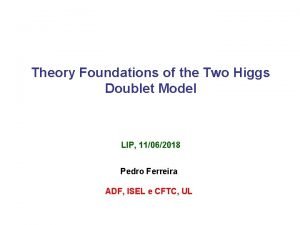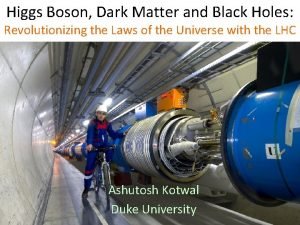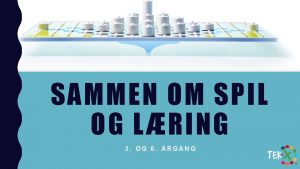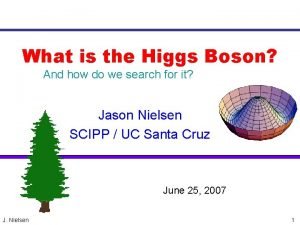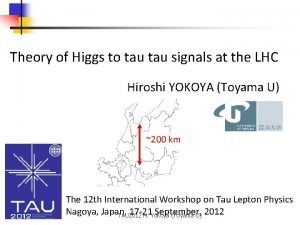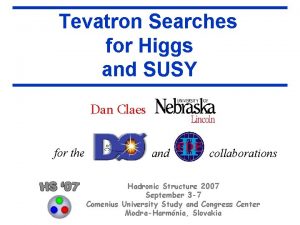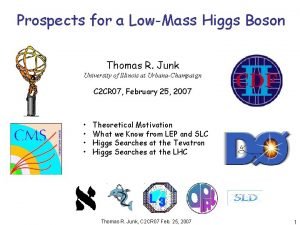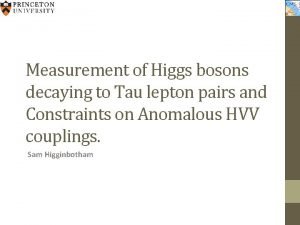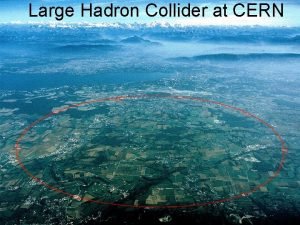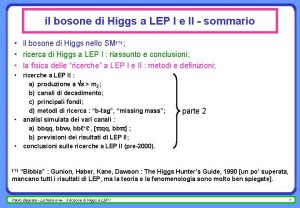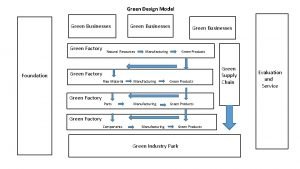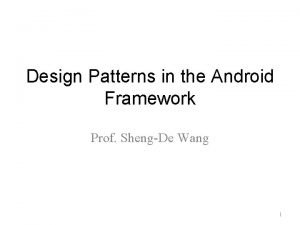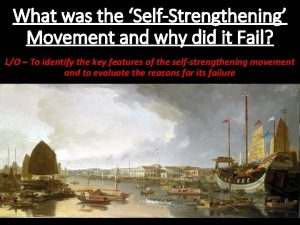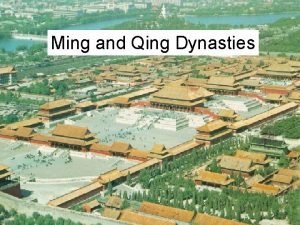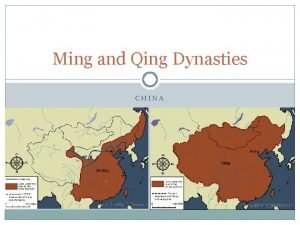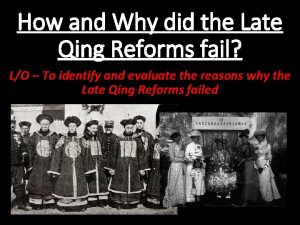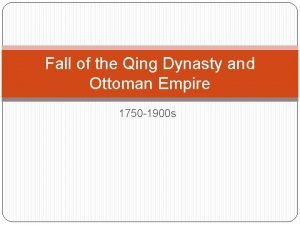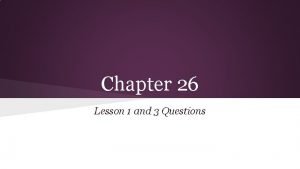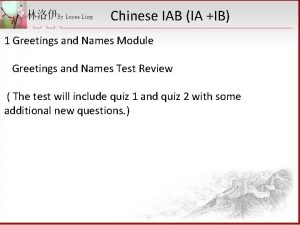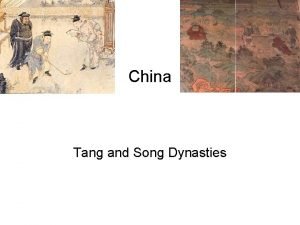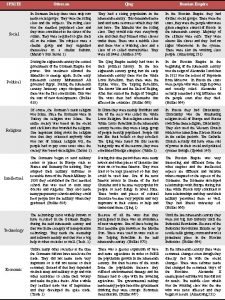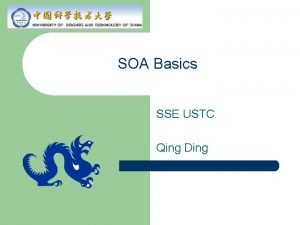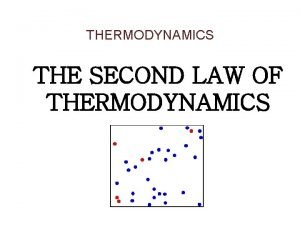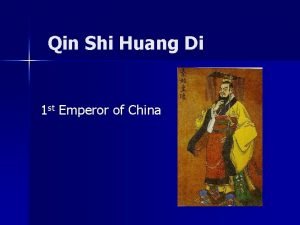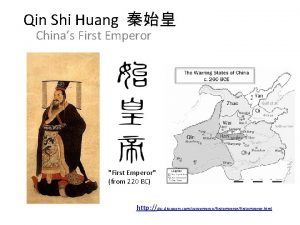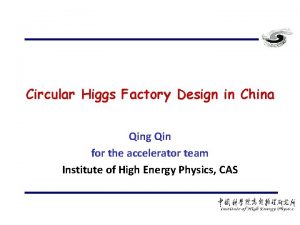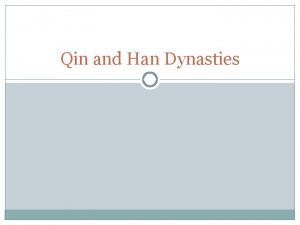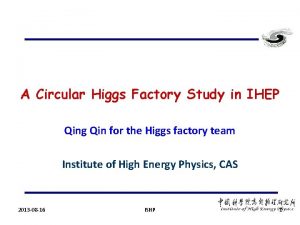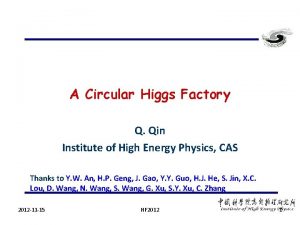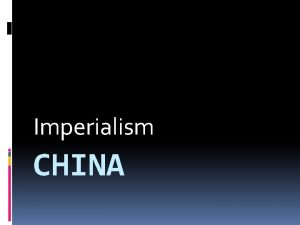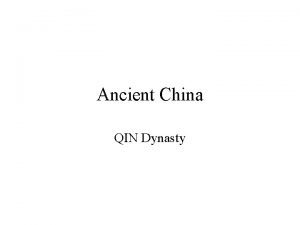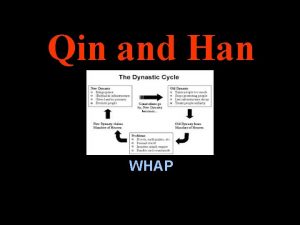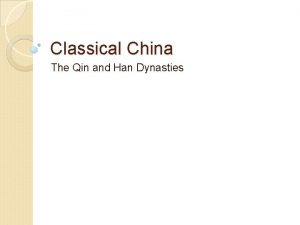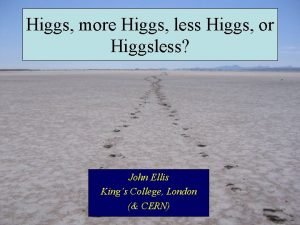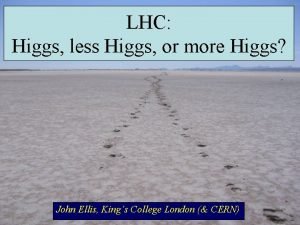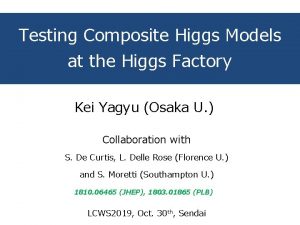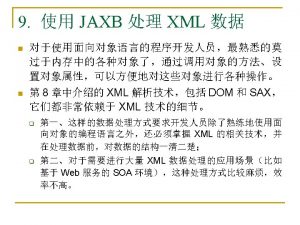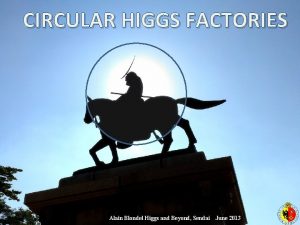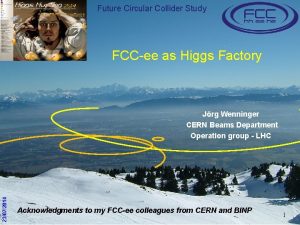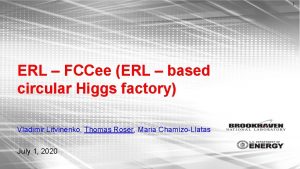Circular Higgs Factory Design in China Qing Qin















![Beamstrahlung • Beamstrahlung fractional energy spread[1]: • Beamstrahlung bending radius : the collision length Beamstrahlung • Beamstrahlung fractional energy spread[1]: • Beamstrahlung bending radius : the collision length](https://slidetodoc.com/presentation_image/4b1d5d3b026446273deba2211c547fb8/image-16.jpg)

















![Collective effects • CEPC ring wake and impedance budget R [kΩ] L [n. H] Collective effects • CEPC ring wake and impedance budget R [kΩ] L [n. H]](https://slidetodoc.com/presentation_image/4b1d5d3b026446273deba2211c547fb8/image-34.jpg)


















- Slides: 52

Circular Higgs Factory Design in China Qing Qin for the accelerator team Institute of High Energy Physics, CAS

Outlines • Introduction • Parameter determination of CEPC • Main AP issues • Plan in the near future • Summary

1. Introduction • Motivations – Higgs Boson was discovered two years ago, with a lower energy than expected. – Circular collider seems more mature and promising – More high energy physics hide in a possible pp collider converted by electron machine

Forthcoming Discoveries in Particle Physics Topic Crucial measurement Significance WIMP Existence Dark Mater Higgs boson M ~125 Ge. V Confirm spontaneous symmetry breaking in gauge theory Super-symmetric particles Existence, M > 1 Te. V Hope of understanding gravity Technicolour particles Existence, M > Te. V? Dynamic symmetry breaking, Composite Higgs Gravitational waves (Gravitons) Existence Support general relativity Magnetic monopole Existence, mass, electric charge Electric and magnetic charge symmetry predicted by Dirac. Structure of gauge field configuration Free quarks Existence, fractional charge Would confuse all current prejudice Neutrino mass and oscillation M < 1 e. V Structure of GUTs. Eventual fate of the universe Exotic hadron Glueball Mg = 1 -2 Ge. V, Mexotic, c~4 Ge. V Existence Understand QCD 4

Possible Higgs Factories • Linear Collider u ILC u CLIC u SLC-type u Advanced concepts

• Higgs 厂之二: – γ- γ collider u SAPPHIRE – ERL based, γ-γ based on LHe. C, … u CLICHÉ – CLIC Higgs Experiment Need powerful laser…

Proton Linac 8 Ge. V • Muon collider Accumulator, Buncher +4 1 bunch combiner Hg target u Driven by high power p accelerator Drift, Bunch, Cool u MW level target,collect pion to muon u Cooling of Muon u Acceleration, collision ring, detector… Linac RLA s Collider Ring D. Neuffer AAC 12 Nu. FACT 12

• Circular e-e+ collider u LEP 3 u TLEP u Super-Tristan u FNAL Site-filler u IHEP:CEPC+Spp. C FNAL Site-filler

• A CEPC (phase I) + Spp. C (phase II) was proposed in IHEP, Sept. 2012 pp collider Spp. C: 50 – 90 Te. V CEPC: 240 – 250 Ge. V e-e+ Higgs Factory

Higgs Factory Accelerator Pros and Cons (S. Henderson) Linear Collider Circular Collider Muon Collider γ-γ Collider Te. V Upgradability (Cost, Size, Power) pp collider convertible Technical Maturity Size Cost Power Consumption Energy Resolution MDI Te. V Upgradability (Energy)

Luminosity requirement • e−−e+ collider: – Higgs produced above the ZH threshold – Collide at Ecm~240 Ge. V,σ~ 200 fb – Need 20000 events/yr/IP,i. e. , 100 fb-1/y —> L = 1034 cm-2 s-1 • Muon collider – Higgs produced from s-channel – σ~ 40 pb – 20000 Higgs/yr —> L = 5*1031 cm-2 s-1 Design Goal

Possible circular collider • In the existing tunnel: – LEP 3, together w/LHC (27 km) • Using lab field: – Fermilab Site Filler (16 km) • Others: – – – DLEP (53 km), TLEP (80 km) Super-Tristan (40, 60 km) IHEP:CEPC+Spp. C (50, 70 km) Very Large Lepton Collider (233 km in VLHC tunnel) etc.

2. Parameter determination of CEPC • Schematic layout • Linac + booster as injectors • Eb=120 Ge. V – Limited by beamstrahlung (~125 Ge. V) e+ e- LTB CEPC (50 km-100 km ) Boostr(50 Km -100 km) Spp. C 50 -1 00 Km) • Cross-section = 200 fb Alain Blondal et al

• Circumference – Determined by Spp. C beam energy – Assume Ecm=100 Te. V for new physics Ec. m. (Te. V) B (T) C (km) 100 12 ~80 100 20 ~50 • Beam power – 50 MW/beam, synchrotron radiation • Luminosity – 1× 1034 cm-2 s-1/IP

• Beam current: • Take filling factor of the ring = 0. 78 ρ = 6. 2 km
![Beamstrahlung Beamstrahlung fractional energy spread1 Beamstrahlung bending radius the collision length Beamstrahlung • Beamstrahlung fractional energy spread[1]: • Beamstrahlung bending radius : the collision length](https://slidetodoc.com/presentation_image/4b1d5d3b026446273deba2211c547fb8/image-16.jpg)
Beamstrahlung • Beamstrahlung fractional energy spread[1]: • Beamstrahlung bending radius : the collision length for head-on and for crab waist collision [1] H. Wiedemann, SLAC-PUB-2849, 1981.

Bunch number, particle number, emittance • Small Ne will reduce δBS , but increase Nb and decrease ξx to keep luminosity • Nb = 50

Luminosity & coupling coefficient • Take PSR = 50 MW, E = 120 Ge. V, εx = 6. 69 nm, r = 0. 005 (empirical value)

RF frequency and voltage • Energy spread and acceptance due to SR • Synchrotron tune and bunch length: • RF station distribute around the ring due to energy saw tooth • Lifetime from beamstrahlung:

• For chosen transvers bunch size and Ne , beam lifetime due to beamstrahlung as a function of Vrf at different frf. • For σz<3 mm, νs<0. 3, δBS <σe/3, η <0. 05 & τ >10 min, the corelation between αp and Vrf can be got: frf = 700 MHz frf = 1. 3 GHz

Main parameters of CEPC ring Number of IPs Beam Energy (Ge. V) Circumference (km) SR loss/turn (Ge. V) Ne/bunch (1011) Bunch number Beam current (m. A) SR power /beam (MW) B 0 (T) Bending radius (km) Momentum compaction (10 -4) βIP x/y (mm) 2 120 53. 6 3 3. 5 50 16. 9 50 0. 065 6. 2 0. 4 800/1. 2 Emittance x/y (nm) Transverse σIP (um) ξx/IP ξy/IP 6. 9/0. 021 74. 3/0. 16 0. 097 0. 068 VRF (GV) Nature bunch length σz (mm) Bunch length include BS (mm) Nature Energy spread (%) 6. 87 2. 12 2. 42 0. 13 Energy acceptance RF(%) nγ δBS (%) 5. 4 0. 22 0. 07 Lmax/IP (1034 cm-2 s-1) 1. 76

3. Main Accelerator Physics Issues • Lattice Design In current design: • Circumference: 53. 6 km • 16*arcs: 48. 4 km • 14*short straight: 14*144 m=2. 0 km • 2*IPs: 2*576 m=1. 2 km Ø 8 RF cavities are uniformly distributed in every other straights. Ø The other 6 straights can be used for injection and dump. Not fixed yet !

Lattice of arc sections Ø Length of FODO cell: 48 m Ø Phase advance of FODO cells: 60/60 degrees Ø Dispersion suppressor on each side of every arc Ø Length: 96 m

Lattice of straight sections Ø Length straight: 144 m Ø Phase advance of FODO cells: 60/60 degrees Ø FFS is temporarily replaced by FODO cells Ø Length of each IP section: 576 m Ø Used for workpoint adjustment

Tune diagram of CEPC lattice Work point: (178. 73, 179. 12)

Dynamic aperture (w/o FFS) u 2 sextupole families are applied to correct chromaticity u dynamic aperture: ~100σ x in hori. ~150σ y in vert. 26

Pretzel scheme u 2 sets of electrostatic separators u horizontal separation,5 × (rms bunch size) u maximum bunch number = 96

FFS in CEPC • Functions of Interaction Region (IR) optics – Provide very small beta function to achieve very small beam size: βy*=1. 2 mm, σy*=0. 16 um, for CEPC – Correct large chromaticity due to small beta function: W~L*/ βy* Based on Yunhai’s design L*=2. 5 m βx*=0. 8 m βy*=1. 2 mm

FFS in CEPC – Dynamic aperture is small due to large chromaticity at final doublet which is difficult to well correct – Reduce chromaticity at final doublet by reducing L* from 2. 5 m to 1. 5 m (still in progress) FT: final IP FT CCY CCX MT L*=1. 5 m M=-I CEPC IR L*=1. 5 m, Sep 2014, by Yiwei Wang telescopic transformer CCY: chromatic correction section Y CCX: chromatic correction section X MT: matching telescopic transformer

Beam-beam study • Tune scan (studied with Yuan Zhang’s code) Beamstrahlung OFF Beamstrahlung ON

• Tune Scan w/ Beamstrahlung 16. 9 m. A*16. 9 m. A, 50 bunches, BBWS, Luminosity ~ 1. 6 e 34 (0. 52, 0. 61) Quasi-Strong simulation shows Luminosity ~ 1. 1 e 34

• New working points from beam-beam simulation (. 54,. 62)

• Beam Lifetime vs dynamic aperture Simulation & analysis not so consistent
![Collective effects CEPC ring wake and impedance budget R kΩ L n H Collective effects • CEPC ring wake and impedance budget R [kΩ] L [n. H]](https://slidetodoc.com/presentation_image/4b1d5d3b026446273deba2211c547fb8/image-34.jpg)
Collective effects • CEPC ring wake and impedance budget R [kΩ] L [n. H] kloss [V/p. C] |Z///n|eff [Ω] Resistive wall (Al) 6. 6 87. 1 210. 9 0. 0031 RF cavities (N=400) 29. 3 -- 931. 2 --- Total 35. 9 87. 1 1142. 1 0. 0031 • The longitudinal wake is fitted with the analytical model • The loss is dominated by the RF cavities. The imaginary part of the RF cavities is capacitive. • Longitudinal wake at nominal bunch length (σz=2. 66 mm) 34

• Bunch lengthening – Steady-state bunch shape is obtained by Haissinski equation – Bunch is shortened due to the capacitive impedance of the RF cavity(only resistive wall and RF cavity considered) Pseudo-Green function wake (σz=0. 5 mm) Steady-state bunch shape

• Bunch lengthening with scaled Super. KEKB’s geometry wake – Scaled LER wake+RW+RF (bunch is lengthened by 9. 0%) – Scaled HER wake+RW+RF (bunch is lengthened by 18. 5%) The scaling factor is Cir (CEPC)/Cir(Super. KEKB)=53. 6 e 3/3016. 315 36

• CSR is not a problem in CEPC, with preliminary analyses • TMCI – The threshold of transverse impedance is |Z| < 28. 3 MΩ/m. – The equivalent longitudinal impedance is 2. 66 Ω, which is much larger than that of the longitudinal instability. • Eigen mode analysis • Considering only resistive wall impedance • Beam current threshold: – Ibth=11. 6 m. A (I 0 th=578 m. A) – Safe for CEPC ring

• Ion instability, ECI, will be less affected due to the other counter-rotating beam in the same vacuum chamber • Due to pretzel scheme, when a beam cross a resonator (eg. RF cavity), the wake field excited by the beam will affect the other beam, i. e. the two beams will cross talk to each other. • Some new physics…

Injection 6~10 Ge. V Energy Ramp 10 ->120 Ge. V Electron Linac Booster Positron Collision ring 120 Ge. V

Geometrical Arrangement Booster 2 m Collision ring

Septum Kicker Twiss Parameters of the injection region

Injection time structure Tlife(s) 1800 Lum Drop 10% Injection period Injection time ~10 s: d. N 9 E 11 finjection(s) 90 s

Injection Options Bump height Bumped Stored beam Septum Injected beam 5 sxc Acceptance 5 sxi X’ B = 10 sxi + S X 5 sxc + 5 sxi + S

Booster & linac • Preliminary design for booster and transport lines • Maybe a smaller booster with lower beam energy is necessary

Unpolarized linac

Polarized linac • Polarized Electron Source (R&D) n Polarized electron gun for En Polarized electron beam collide with unpolarized positron

4. Plan in the near future • CPEC – Pre-study, R&D and preparation work • Pre-study: 2013 -15 Pre-CDR by 2014 • R&D: 2016 -2020 • Engineering Design: 2015 -2020 – Construction: 2021 -2027 – Data taking: 2030 -2036 • SPPC – Pre-study, R&D and preparation work • Pre-study: 2013 -2020 • R&D: 2020 -2030 • Engineering Design: 2030 -2035 – Construction: 2036 -2042 – Data taking: 2042 -

Livingston Chart(energy) ✗

Livingston Chart(luminosity) ✗

Summary • A possible ring-based Higgs factory, CEPC is being studied and its R&D will be proposed in the near future. • Accelerator physics of CEPC ring, are discussed. But still a lot of important issues, background, MDI, error effect, etc. , need further studies. • Hardware is also being considering, and some key tech are proposed. • International collaborations are necessary.

Acknowledgement • IHEP: H. P. Geng, Y. Zhang, Y. Y. Guo, N. Wang, Y. W. Wang, J. Gao, D. Wang, X. H. Cui, G. Xu, C. Zhang, G. X. Pei, X. P. Li, etc. • FNAL: W. Chou • SLAC: Y. H. Cai • KEK: K. Ohmi, Y. Funakoshi, K. Oide, etc. • CERN: F. Zimmermann, etc. • Jlab: Y. H. Zhang • ……

Thanks for your attention!
 Qing qing ting
Qing qing ting Scence
Scence Higgs factory
Higgs factory Higgs factory
Higgs factory China at its height
China at its height Height of the qing dynasty
Height of the qing dynasty China qin dynasty map
China qin dynasty map Qin
Qin Java factory factory joke
Java factory factory joke Hvac seismic cable tools supplier
Hvac seismic cable tools supplier Mas.863
Mas.863 Higgs singlet
Higgs singlet Higgs singlet
Higgs singlet Marcela carena
Marcela carena Higgs doublet
Higgs doublet Richard feynman
Richard feynman Chelsea higgs wise
Chelsea higgs wise Hungry higgs spil
Hungry higgs spil Higgs boson
Higgs boson Higgs to tau tau
Higgs to tau tau Higgs
Higgs Higgs boson
Higgs boson Higgs
Higgs Playfer
Playfer Higgs
Higgs Element in hair
Element in hair China vdq pulley of circular knitting machine
China vdq pulley of circular knitting machine Factory design pattern
Factory design pattern Factory design pattern java
Factory design pattern java Upset forging die design factory
Upset forging die design factory Green factory design
Green factory design Design patterns android
Design patterns android Azure data factory features
Azure data factory features Conferência de berlim self-strengthening movement
Conferência de berlim self-strengthening movement Rise of the qing dynasty
Rise of the qing dynasty Qing conquest of the ming
Qing conquest of the ming Ming dynasty time period
Ming dynasty time period Qing conquest of the ming
Qing conquest of the ming Late qing reforms
Late qing reforms The fall of the qing dynasty
The fall of the qing dynasty Song dynasty social structure
Song dynasty social structure Decline of qing dynasty
Decline of qing dynasty Chapter 26 lesson 1 the decline of the qing dynasty
Chapter 26 lesson 1 the decline of the qing dynasty Qing dynasty dbq
Qing dynasty dbq Qing wen nin gui xing
Qing wen nin gui xing Venn diagram of tang and song dynasties
Venn diagram of tang and song dynasties Lain orang lain ragam
Lain orang lain ragam Qing dynasty social classes
Qing dynasty social classes Qing ding
Qing ding Chapter 14 section 1 the search for spices
Chapter 14 section 1 the search for spices Wnet = qin - qout
Wnet = qin - qout Quotes about qin shi huangdi
Quotes about qin shi huangdi Qin shi huang ror
Qin shi huang ror

